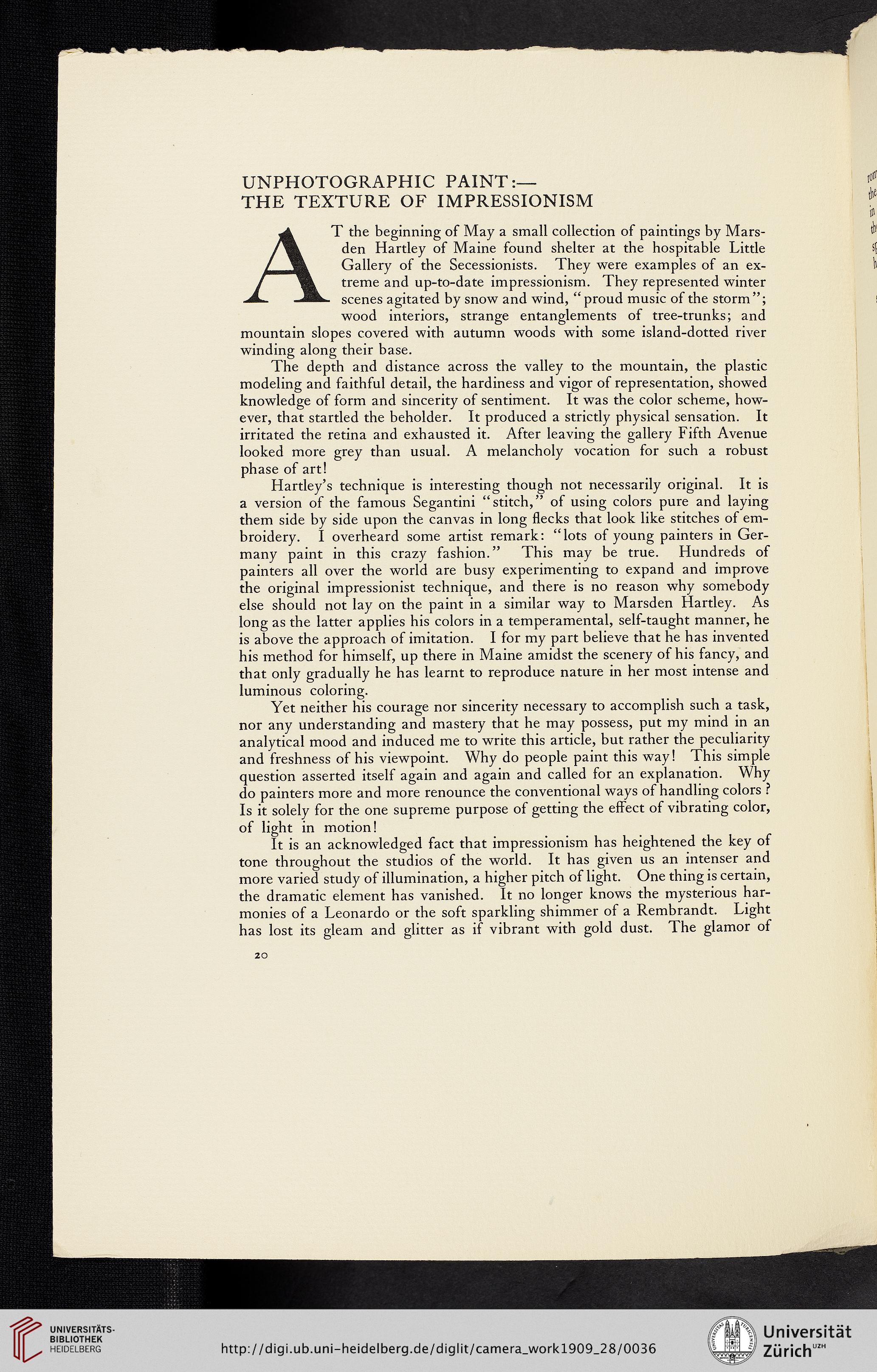Für diese Seite ist auch eine manuell angefertigte Transkription bzw. Edition verfügbar. Bitte wechseln Sie dafür zum Reiter "Transkription" oder "Edition".
UNPHOTOGRAPHIC PAINT:—
THE TEXTURE OF IMPRESSIONISM
AT the beginning of May a small collection of paintings by Mars-
den Hartley of Maine found shelter at the hospitable Little
Gallery of the Secessionists. They were examples of an ex-
treme and up-to-date impressionism. They represented winter
scenes agitated by snow and wind, “ proud music of the storm”;
wood interiors, strange entanglements of tree-trunks; and
mountain slopes covered with autumn woods with some island-dotted river
winding along their base.
The depth and distance across the valley to the mountain, the plastic
modeling and faithful detail, the hardiness and vigor of representation, showed
knowledge of form and sincerity of sentiment. It was the color scheme, how-
ever, that startled the beholder. It produced a strictly physical sensation. It
irritated the retina and exhausted it. After leaving the gallery Fifth Avenue
looked more grey than usual. A melancholy vocation for such a robust
phase of art!
Hartley’s technique is interesting though not necessarily original. It is
a version of the famous Segantini “stitch,” of using colors pure and laying
them side by side upon the canvas in long flecks that look like stitches of em-
broidery. I overheard some artist remark: “lots of young painters in Ger-
many paint in this crazy fashion.” This may be true. Hundreds of
painters all over the world are busy experimenting to expand and improve
the original impressionist technique, and there is no reason why somebody
else should not lay on the paint in a similar way to Marsden Hartley. As
long as the latter applies his colors in a temperamental, self-taught manner, he
is above the approach of imitation. I for my part believe that he has invented
his method for himself, up there in Maine amidst the scenery of his fancy, and
that only gradually he has learnt to reproduce nature in her most intense and
luminous coloring.
Yet neither his courage nor sincerity necessary to accomplish such a task,
nor any understanding and mastery that he may possess, put my mind in an
analytical mood and induced me to write this article, but rather the peculiarity
and freshness of his viewpoint. Why do people paint this way! This simple
question asserted itself again and again and called for an explanation. Why
do painters more and more renounce the conventional ways of handling colors ?
Is it solely for the one supreme purpose of getting the effect of vibrating color,
of light in motion!
It is an acknowledged fact that impressionism has heightened the key of
tone throughout the studios of the world. It has given us an intenser and
more varied study of illumination, a higher pitch of light. One thing is certain,
the dramatic element has vanished. It no longer knows the mysterious har-
monies of a Leonardo or the soft sparkling shimmer of a Rembrandt. Light
has lost its gleam and glitter as if vibrant with gold dust. The glamor of
20
THE TEXTURE OF IMPRESSIONISM
AT the beginning of May a small collection of paintings by Mars-
den Hartley of Maine found shelter at the hospitable Little
Gallery of the Secessionists. They were examples of an ex-
treme and up-to-date impressionism. They represented winter
scenes agitated by snow and wind, “ proud music of the storm”;
wood interiors, strange entanglements of tree-trunks; and
mountain slopes covered with autumn woods with some island-dotted river
winding along their base.
The depth and distance across the valley to the mountain, the plastic
modeling and faithful detail, the hardiness and vigor of representation, showed
knowledge of form and sincerity of sentiment. It was the color scheme, how-
ever, that startled the beholder. It produced a strictly physical sensation. It
irritated the retina and exhausted it. After leaving the gallery Fifth Avenue
looked more grey than usual. A melancholy vocation for such a robust
phase of art!
Hartley’s technique is interesting though not necessarily original. It is
a version of the famous Segantini “stitch,” of using colors pure and laying
them side by side upon the canvas in long flecks that look like stitches of em-
broidery. I overheard some artist remark: “lots of young painters in Ger-
many paint in this crazy fashion.” This may be true. Hundreds of
painters all over the world are busy experimenting to expand and improve
the original impressionist technique, and there is no reason why somebody
else should not lay on the paint in a similar way to Marsden Hartley. As
long as the latter applies his colors in a temperamental, self-taught manner, he
is above the approach of imitation. I for my part believe that he has invented
his method for himself, up there in Maine amidst the scenery of his fancy, and
that only gradually he has learnt to reproduce nature in her most intense and
luminous coloring.
Yet neither his courage nor sincerity necessary to accomplish such a task,
nor any understanding and mastery that he may possess, put my mind in an
analytical mood and induced me to write this article, but rather the peculiarity
and freshness of his viewpoint. Why do people paint this way! This simple
question asserted itself again and again and called for an explanation. Why
do painters more and more renounce the conventional ways of handling colors ?
Is it solely for the one supreme purpose of getting the effect of vibrating color,
of light in motion!
It is an acknowledged fact that impressionism has heightened the key of
tone throughout the studios of the world. It has given us an intenser and
more varied study of illumination, a higher pitch of light. One thing is certain,
the dramatic element has vanished. It no longer knows the mysterious har-
monies of a Leonardo or the soft sparkling shimmer of a Rembrandt. Light
has lost its gleam and glitter as if vibrant with gold dust. The glamor of
20


